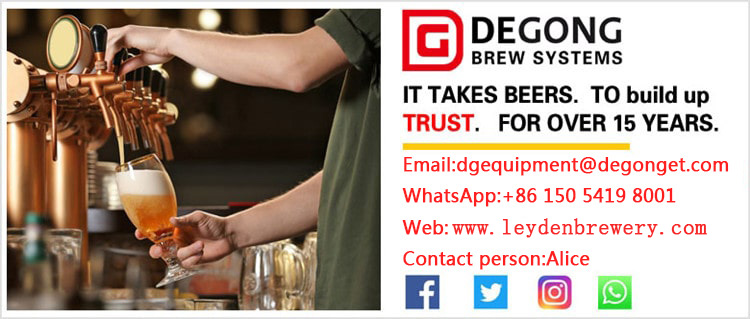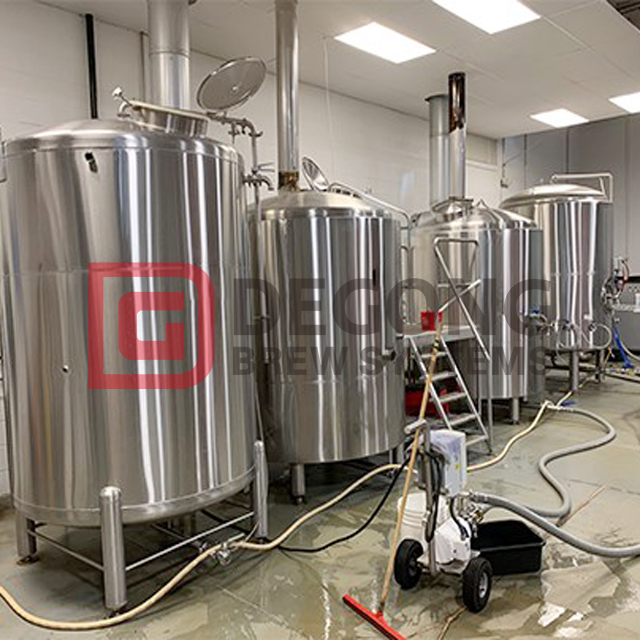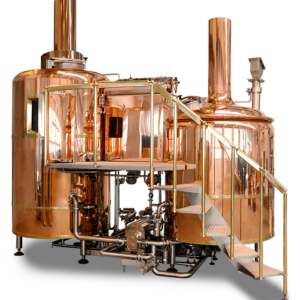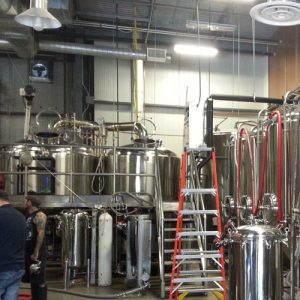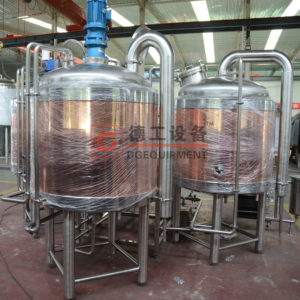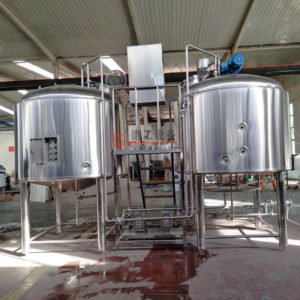Description
Whether you are an enthusiastic home brewer, a brew pub, a microbrewery, or a craft brewery, DEGONG has the devices you need.
We are happy to be able to supply you with nearly any equipment you may need. Whether it be microbrewery or commercial brewery, we can supply you with any unique beer equipment you may need to support you with your unique creation.
When it comes to buying the main equipment for your brewery, there are several factors to consider. In this guide, we’ll take a look at the essential pieces you’ll need, and discuss the various options where relevant.
The brewery can be split into two major sections. The first is the brewhouse, also known as the ‘hot side’. This is where the first stage of brewing is completed, from milling to mashing, and boiling to chilling the wort.
The second section is the cellar, also known as the ‘cold side’. This is where fermentation, conditioning, dry hopping, and everything else that happens as wort becomes beer takes place. Most brewery equipment falls into one of these two sections, with a few exceptions.
BREWHOUSE (HOT SIDE) ESSENTIALS Pub brewing systems
The brewhouse consists of various heated vessels, with pumps to transport the wort.
HEAT SOURCE for brewing systems
The first decision to make is how you will heat your brewing vessels. The most common methods are:
1.Steam
Steam heated vessels are fairly common and require a steam generator. This simply transforms city water into boiling steam, which is then piped into steam jackets that are fitted on your vessels. Steam generators are typically powered by either natural gas, electricity, or diesel. They require a water softening system, which is normally sold with the generator. Steam tends to offer more control than other heating methods, as the input of steam can be finely adjusted.
2.Electricity
Vessels heated by electricity typically use elements, similar to those found in a common kitchen kettle. These come in various sizes and powers, and the best have 2 or 3 elements that can be switched off and on, providing a level of control over the heating. Electrical brewhouses have the elements in-built, and don’t require additional equipment.
MALT MILL
Only necessary if you’re using uncrushed malt. Look for models that are easily adjustable. The most common models have 2 rollers, which is adequate for the needs of most small breweries, though some have 3 or more. Depending on your space, you may need a model that is easily maneuvered. Suppliers typically list the capacity in terms of weight of malt per hour.
HOT LIQUOR/WATER TANK (HLT)
The HLT stores and heats up your brewing water. The best models have at least two heating elements or steam jackets, allowing you to start heating with just a small amount of water in the vessel. Your HLT should have a level indicator for easy calculations.
In terms of size, it should be around double the size of the rest of your brewhouse. So, if you have a 500 litre boil kettle, you should order a 1,000 litre HLT. This will ensure you always have enough liquid for strike water, sparging, and cleaning.
It should also be fitted with a pump that connects to the mash tun and sparge set up via a flowmeter, as well as the CIP valves on the rest of your equipment. The pump should also allow for recirculation to ensure accurate temperature readings and even mixing of cleaning agents or sparge water additions if you’re using them.
FLOWMETER
The flowmeter is used to accurately measure strike and sparge water. It should be heat resistant and waterproof.
MASH TUN
There are many types of mash tun, from the most simple open vessels, to enclosed, heated vessels, fitted with stirring paddles. The more features, the higher the cost. For larger outputs (higher than 200 litres or so), it becomes difficult to mix the mash by hand. If you plan to use step mashing, you’ll need a mash tun that can be heated.
It should also be fitted with a pump that transports the mash to the lauter tun. Desirable extras include the ability to recirculate for more consistent temperatures, and an inbuilt temperature probe.
LAUTER TUN
The lauter tun is fitted with a filter, used to separate the sweet wort from the grain. It is also fitted with a sparge ring, connected to the HLT via the flowmeter. The ability to recirculate the hot wort back over the grain is extremely useful for clarifying the wort before transferring to the boil kettle. It’s not typically necessary for the lauter tun to be heated. During the sparging process, the filtered hot wort will be pumped to the boil kettle.
You will typically need a spent grain outlet – a side mounted door from which the spent grains can be pulled out and disposed of easily.
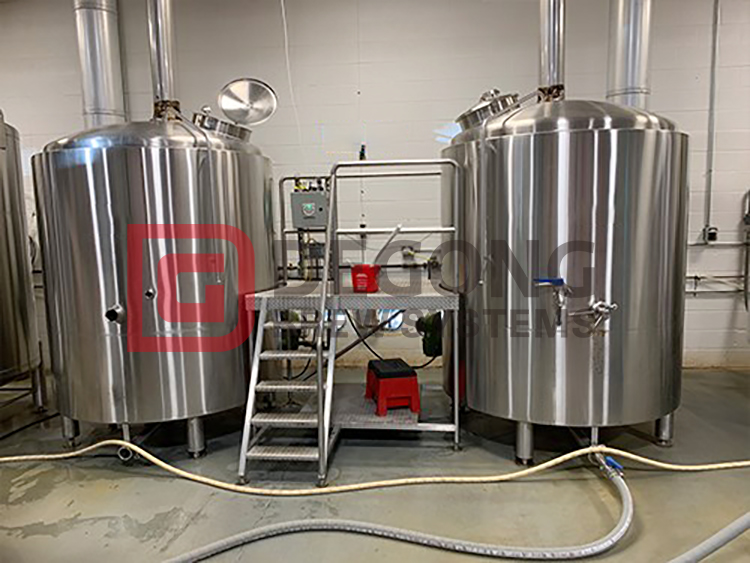
Brewhouse systems
BOIL KETTLE
A relatively simple, heated vessel, the best can start heating the wort with as little as 20 litres inside, reducing the time taken to reach a boil. Depending on your space, you may need a condenser. This draws the steam (and other unwanted compounds) out of an enclosed boil kettle. Alternatively, if space allows, fit a flue that leads outside.
WHIRLPOOL
The whirlpool vessel isn’t absolutely necessary, depending on the type of beer you’re producing. It can be used for late hop additions, and dropping solids out of suspension before transferring to the heat exchanger.
HEAT EXCHANGER
Used to drop the temperature of the boiling wort before transferring to the fermenting vessel. The most common type in breweries is a plate heat exchanger (PHE). The beer flows through one side, and cold water and glycol (or ice water) passes through the other. It should come with at least a thermometer in the beer outlet.
There are several configurations. The most common include a hop filter or even a hopback before the PHE, and a yeast tank and oxygenation system after the PHE. They come in many sizes, often measured in sq. metres. The larger the PHE, the quicker it cools your wort.
As a general rule of thumb, a 500 litre brewhouse doesn’t need much more than a 5 sq metre PHE, a 1,000 litre brewhouse works well with a 10 sq metre PHE, and so on. There should be a pipe that returns the warm city water into the HLT, providing pre-warmed water to save energy costs.
CONTROL PANEL
Control panels come in many shapes and sizes. Common solutions utilize simple PID systems to monitor temperatures and control pumps, and other motorized operations, such as mash paddles, etc. Alternatively, PLC systems offer a touchscreen interface to monitor the entire process, and set automated operations.
The control panel can be restricted to the brewhouse functions, but can also encompass the chilling operations.
